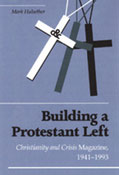Building a Protestant Left
Christianity and Crisis Magazine, 1941-1993

- Author(s): Hulsether, Mark
- Series:
- Imprint: Univ Tennessee Press
- Publication Date: 1999-03-10
- Status: Active
- Available in Hardcover - Cloth: Price $38.00 | Buy Now
Founded in 1941 by Reinhold Niebuhr and others, the magazine Christianity and Crisis (C&C) achieved a level of influence far exceeding its small circulation. A forum for important writers ranging from Paul Tillich to Rosemary Ruether, from George Kennan to Noam Chomsky, from Margaret Mead to Cornel West, from Lewis Mumford to Daniel Berrigan, C&C for half a century commanded great respect in left-liberal circles, both religious and secular.
In Building a Protestant Left, Mark Hulsether uses the history of C&C as a case study to explore changing ideas about religion and society in the latter half of the twentieth century. He follows the twists and turns of this story from Niebuhr’s Christian realist positions of the 1940s, through Protestant participation in the complex social movements of the 1950s and 1960s, to the emergence of various liberation theologies—African American, feminist, Latin American, and others—that used C&C as a central arena of debate in the 1970s and 1980s. Throughout, Hulsether places these changes in the context of postwar cultural and social history, relating C&C’s theological and ethical positions to the broader social and political issues the journal addressed. Included, for example, is an illuminating discussion of C&C’s positions in relation to one of the major developments of recent decades: the rise of neoconservatism and the religious right.
Engagingly written, Building a Protestant Left bridges the gap between secularized history and cultural studies on the one hand and traditional religious studies and religious ethics on the other. It also bridges an important generational gap within public-minded religious thought—it is as well informed on the issues that engaged the magazine during Niebuhr’s heyday (from the 1940 to the 1960s) as on the liberation theologies and other radical positions that came afterward.
The Author: Mark Hulsether is assistant professor of religious studies and American studies at the University of Tennessee, Knoxville.
